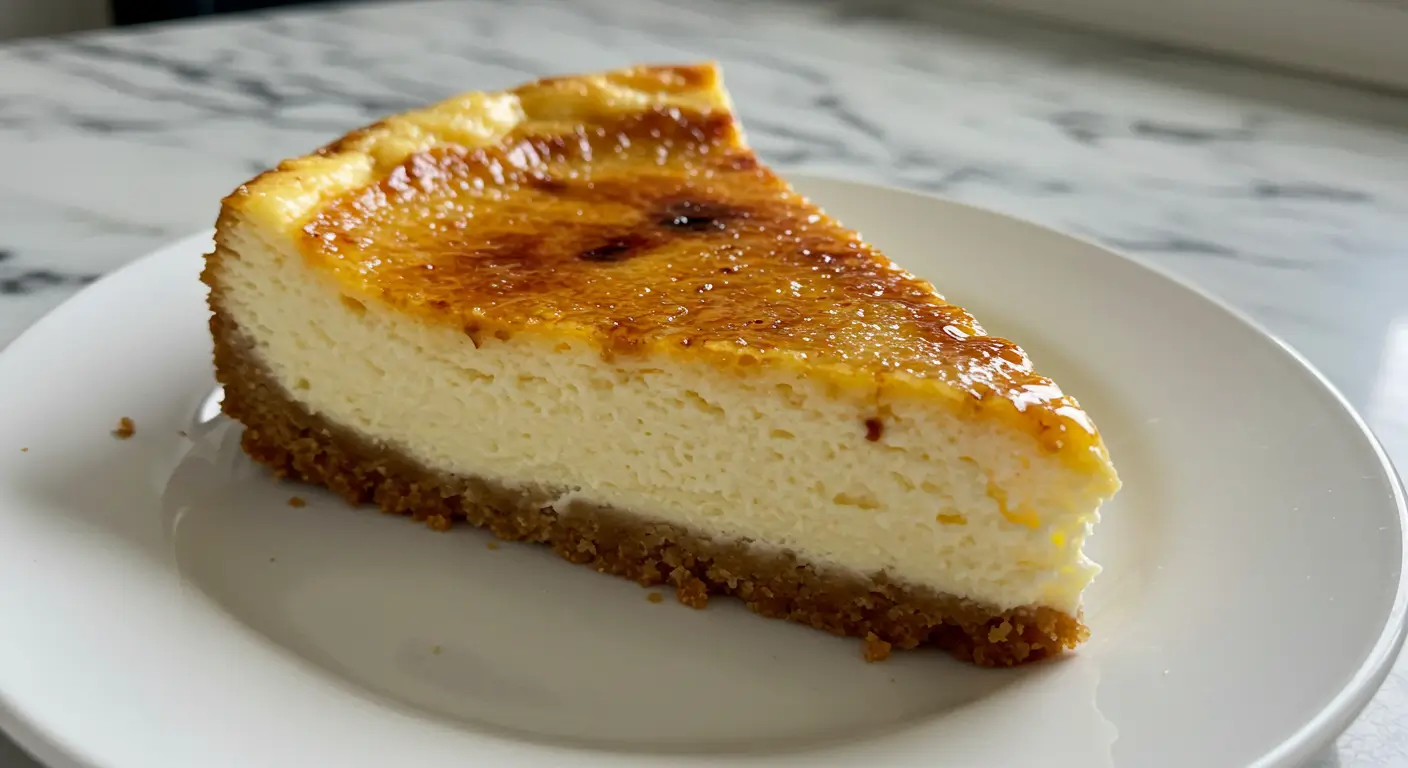Okay, so I messed this up twice before getting it right, but now I’m obsessed. Like, seriously obsessed with this crème brulée cheesecake situation.
It all started when my sister-in-law mentioned she’d tried making one for her husband’s birthday and it was a disaster. Something about the custard layer separating and looking like scrambled eggs. Honestly? I was intrigued. Not by the failure part, but by the idea of combining two of my favorite desserts into one ridiculously decadent creation.
Now, here’s the thing—I’m not a fancy baker. I’m the person who burns cookies and somehow always forgets to set timers. But this recipe? It’s like it was made for people like me who want to look impressive without actually being impressive.
My first attempt was… well, let’s just say my dog got a very expensive treat that day. The second time, I thought I was being smart by cranking up the oven temperature to “speed things along.” Spoiler alert: that’s not how cheesecake works.
But the third time? Magic. Pure, torched-sugar magic.
Table of Contents
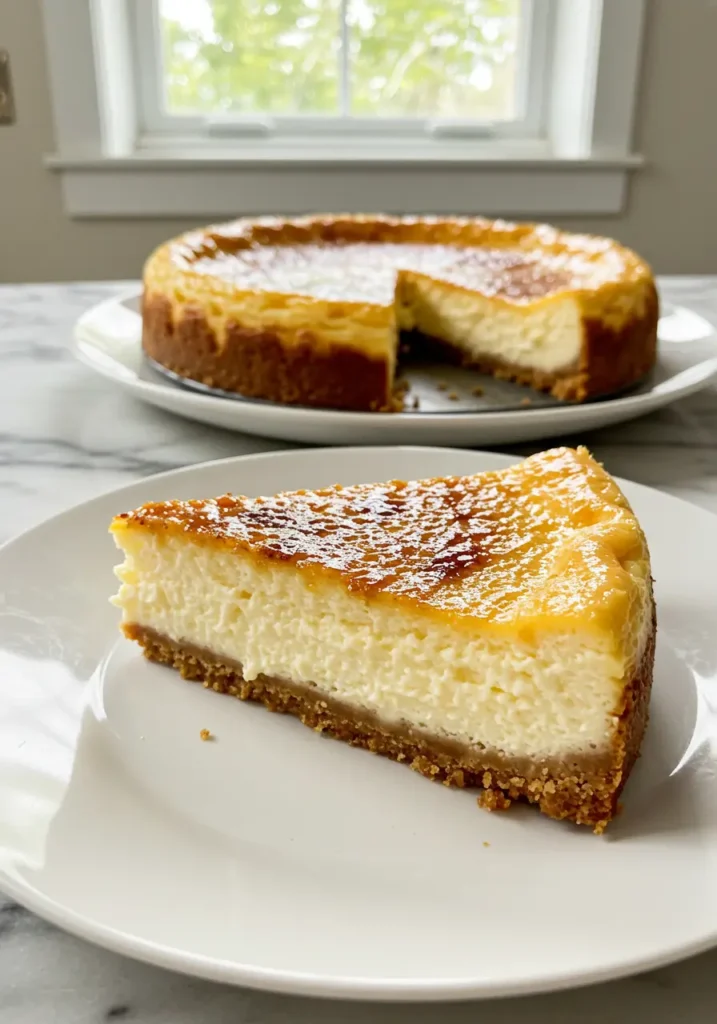
What You’re Getting Into :
This isn’t your average cheesecake, and it’s definitely not your grandma’s crème brulée. It’s this weird, wonderful hybrid that shouldn’t work but absolutely does. The bottom layer is classic New York-style cheesecake—rich, dense, tangy. Then you’ve got this silky vanilla custard layer on top that you get to torch like a pyromaniac. Because yes, you need a kitchen torch for this. Don’t even think about using your oven’s broiler. Tried it. Epic fail.
My neighbor Sarah swears you can make this without the torch, but Sarah also thinks ketchup belongs on mac and cheese, so we’re not taking her advice here.
Shopping Day Reality Check :
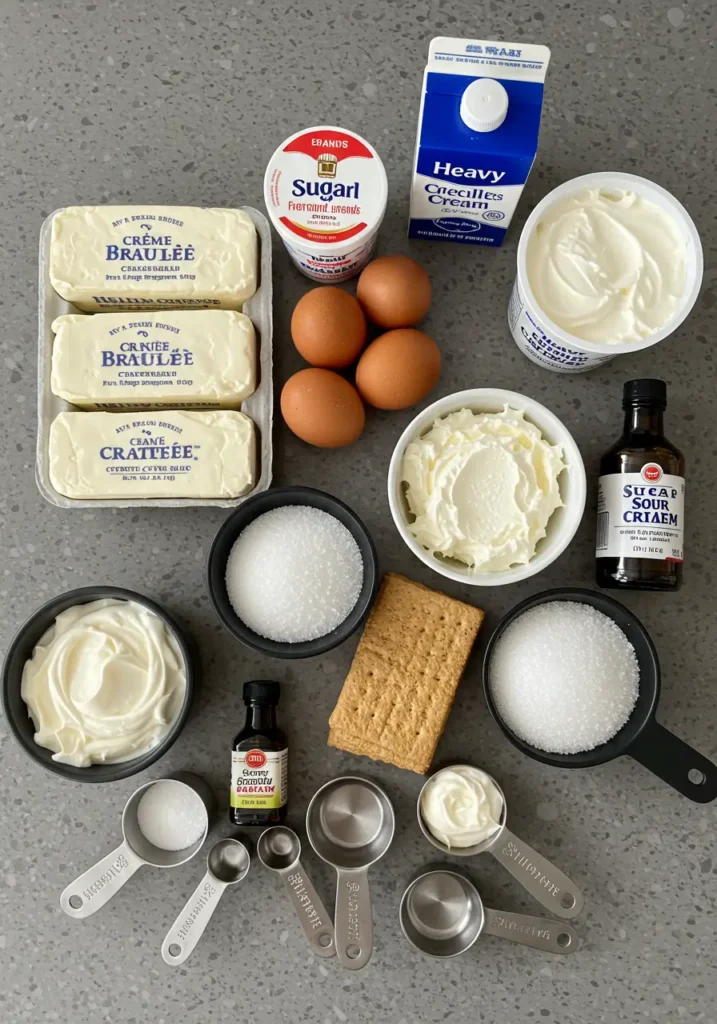
Before we dive in, let’s talk ingredients. You’re gonna need:
For the crust:
- 2 cups graham cracker crumbs (I buy the pre-crushed ones because I’m lazy)
- 1/4 cup granulated sugar
- 6 tablespoons butter, melted (don’t use margarine, just don’t)
For the cheesecake layer:
- 24 oz cream cheese, room temperature (this is crucial—cold cream cheese will give you lumps)
- 3/4 cup granulated sugar
- 3 large eggs
- 1 teaspoon vanilla extract
- 1/4 cup sour cream (I use full-fat because we’re not here to diet)
For the custard layer:
- 1 1/2 cups heavy cream
- 4 large egg yolks
- 1/3 cup granulated sugar
- 1 teaspoon vanilla extract
- Pinch of salt
For the brulée topping:
- 3-4 tablespoons granulated sugar (for torching)
A few shopping tips from someone who’s learned the hard way: don’t buy pre-shredded anything for baking. Those anti-caking agents mess with texture. Also, splurge on real vanilla extract. The fake stuff tastes like sadness, and we’re making something special here.
Oh, and about those eggs—room temperature is key for both the cheesecake and custard. I usually take them out when I start my morning coffee, then bake after lunch. Works perfectly.
The Process (AKA Where Things Get Real) :
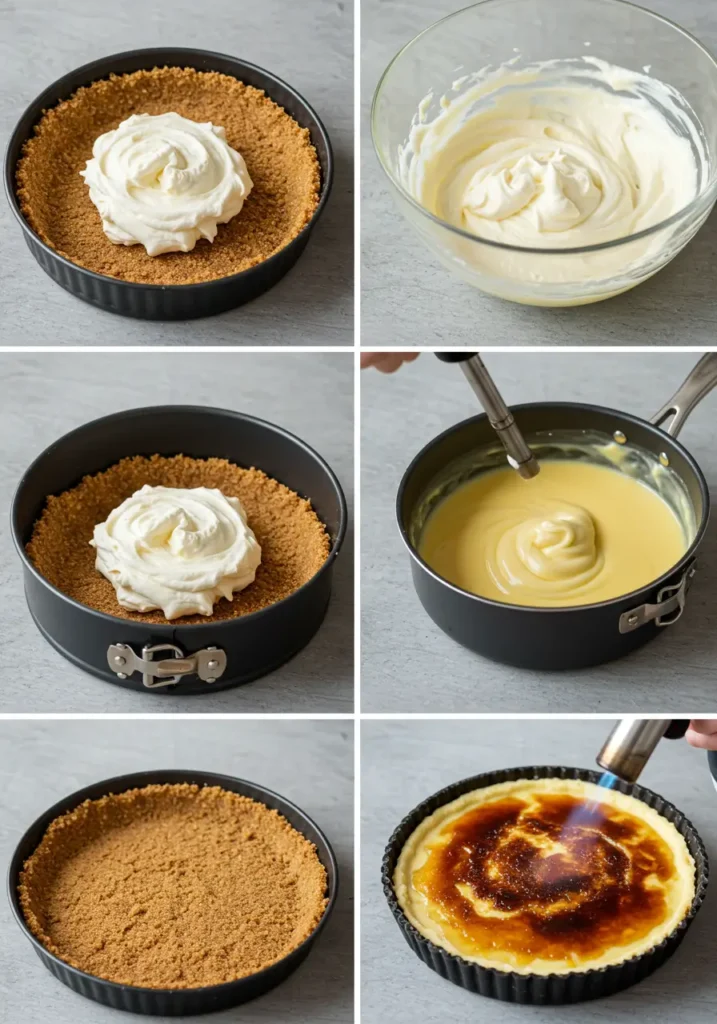
Step 1: Crust Situation
Preheat your oven to 325°F. Trust me on this temperature—I know it seems low, but cheesecake is patient food.
Mix your graham cracker crumbs, sugar, and melted butter in a bowl. It should feel like wet sand. Press this into the bottom of a 9-inch springform pan. I use the bottom of a measuring cup to really pack it down. Pro tip: if you don’t have a springform pan, this recipe will haunt your dreams forever. Just buy one. They’re like $15 at Target.
Bake the crust for 10 minutes. Set a timer. Seriously. I once forgot and came back to charcoal.
Step 2: Cheesecake Drama
While your crust is baking, beat that room-temperature cream cheese until it’s smooth. This takes longer than you think—like 3-4 minutes of actual beating. Don’t rush it.
Add sugar and beat until fluffy. Then add eggs one at a time. Here’s where people mess up: don’t overbeat once the eggs go in. Just mix until combined. Overbeating creates cracks, and nobody wants a cracked cheesecake.
Stir in vanilla and sour cream. Pour this over your baked crust and smooth the top.
Now comes the water bath situation. I used to skip this step and wonder why my cheesecakes always cracked. Don’t be like past me. Wrap the bottom of your springform pan in aluminum foil (double layer if you’re paranoid like I am now), place it in a roasting pan, and add hot water until it comes halfway up the sides.
Bake for 45-55 minutes. The center should still jiggle slightly when you shake the pan. If it’s firm, you’ve gone too far.
Step 3: The Wait (AKA Torture)
This is the hardest part. You have to let the cheesecake cool completely. Like, completely completely. I usually make the cheesecake layer the day before because I have zero patience and will definitely try to add the custard too early if I don’t force myself to wait.
Cool it on the counter for an hour, then refrigerate for at least 4 hours. Overnight is better.
Step 4: Custard Magic
Heat your heavy cream in a saucepan until it’s just starting to simmer. Don’t let it boil—learned this lesson when I created sweet scrambled eggs instead of custard.
While the cream is heating, whisk egg yolks, sugar, vanilla, and salt in a bowl.
Here’s the tricky part: you need to temper the eggs. Pour a tiny bit of the hot cream into the egg mixture while whisking constantly. Then add a bit more. And more. You’re slowly bringing the eggs up to temperature so they don’t cook. Rush this and you’ll have chunks. Nobody wants chunks.
Once you’ve added about half the cream to the eggs, pour the whole mixture back into the saucepan. Cook over medium-low heat, stirring constantly, until it coats the back of a spoon. This takes about 5-7 minutes and will test your patience.
Strain the custard through a fine-mesh sieve to catch any bits that might have cooked despite your best efforts. Let it cool to room temperature.
Step 5: Assembly
Pour the cooled custard over your chilled cheesecake. It should spread evenly and look gorgeous. Refrigerate for another 2-3 hours until the custard is set.
Step 6: The Fun Part
Right before serving, sprinkle a thin, even layer of sugar over the custard. Get your torch out and go to town. Move it in small circles, watching the sugar bubble and turn golden brown. Don’t hold it in one spot too long or you’ll burn it (been there).
The first time I did this, I felt like a culinary wizard. The sugar crackling under the flame, that perfect caramelized smell—it’s addictive.
Real Talk: What Could Go Wrong :
Because I’m nothing if not honest about my failures:
- Custard separates: You rushed the tempering. Start over. I know it sucks.
- Cheesecake cracks: No water bath, or your oven was too hot, or you overbeat the eggs. Still tastes good though.
- Sugar won’t caramelize: Your torch might be dying, or the sugar layer is too thick. Or you bought powdered sugar instead of granulated (don’t ask how I know this).
- Everything tastes weird: Check your vanilla extract. I once grabbed almond extract by mistake and the whole thing tasted like marzipan.
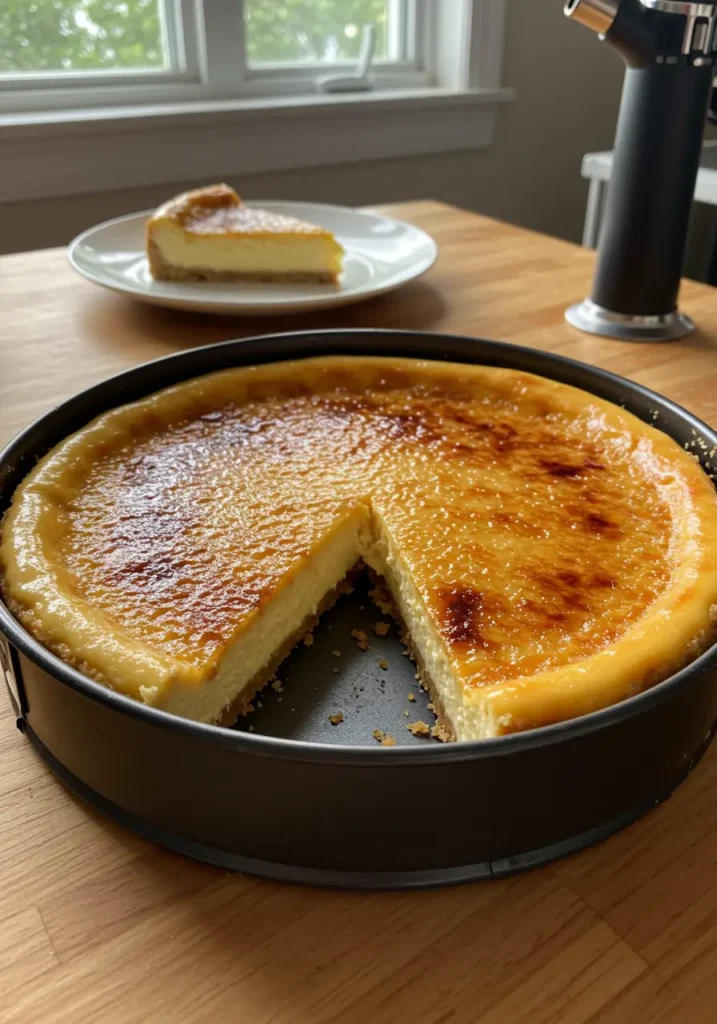
The Verdict :
Look, this isn’t a quick Tuesday night dessert. It’s a weekend project, a special occasion showstopper. But when you crack through that caramelized sugar and get a spoonful of silky custard with rich cheesecake underneath? Worth every moment of waiting.
My mother-in-law, who judges everything I cook, asked for the recipe. Twice. My kids, who usually inhale dessert without comment, actually complimented it. And my husband, bless him, called it “restaurant quality,” which is the highest praise he gives anything that doesn’t come with a side of fries.
Is it perfect? Probably not. Will people think you’re some kind of dessert genius? Absolutely.
Just remember: room temperature ingredients, low and slow baking, patience with the custard, and don’t skip the water bath. Oh, and buy a torch. Trust me on this one.
Now I’m craving this again. Thanks a lot, brain.
Happy baking! (And may your smoke alarms stay quiet) 🔥
Crème Brulée Cheesecake
An indulgent hybrid dessert combining rich New York-style cheesecake with silky vanilla custard and caramelized sugar topping. This showstopping dessert requires patience but delivers restaurant-quality results at home.
Ingredients
- 2 cups graham cracker crumbs
- 1/4 cup granulated sugar (for crust)
- 6 tablespoons butter, melted
- 24 oz cream cheese, room temperature
- 3/4 cup granulated sugar (for cheesecake)
- 3 large eggs
- 1 teaspoon vanilla extract (for cheesecake)
- 1/4 cup sour cream
- 1 1/2 cups heavy cream
- 4 large egg yolks
- 1/3 cup granulated sugar (for custard)
- 1 teaspoon vanilla extract (for custard)
- Pinch of salt
- 3-4 tablespoons granulated sugar (for brulée topping)
Instructions
- Step 1Preheat oven to 325°F. Mix graham cracker crumbs, 1/4 cup sugar, and melted butter. Press into bottom of 9-inch springform pan.
- Step 2Bake crust for 10 minutes. Remove and set aside.
- Step 3Beat room temperature cream cheese until smooth, 3-4 minutes. Add 3/4 cup sugar and beat until fluffy.
- Step 4Add eggs one at a time, mixing just until combined. Stir in vanilla and sour cream.
- Step 5Pour cheesecake mixture over crust. Wrap pan in foil and place in roasting pan with hot water halfway up sides.
- Step 6Bake 45-55 minutes until center still jiggles slightly. Cool completely, then refrigerate 4+ hours.
- Step 7Heat heavy cream until just simmering. Whisk egg yolks, 1/3 cup sugar, vanilla, and salt in bowl.
- Step 8Slowly temper eggs by adding hot cream gradually while whisking. Return mixture to saucepan.
- Step 9Cook custard over medium-low heat, stirring constantly, until it coats the back of a spoon, 5-7 minutes.
- Step 10Strain custard and cool to room temperature. Pour over chilled cheesecake and refrigerate 2-3 hours.
- Step 11Before serving, sprinkle remaining sugar over custard and caramelize with kitchen torch until golden brown.

